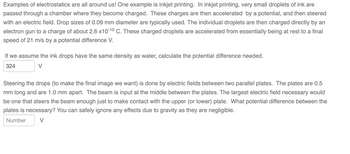Question
Asap plzzz

Transcribed Image Text:Examples of electrostatics are all around us! One example is inkjet printing. In inkjet printing, very small droplets of ink are
passed through a chamber where they become charged. These charges are then accelerated by a potential, and then steered
with an electric field. Drop sizes of 0.09 mm diameter are typically used. The individual droplets are then charged directly by an
electron gun to a charge of about 2.6 x10-10 C. These charged droplets are accelerated from essentially being at rest to a final
speed of 21 m/s by a potential difference V.
If we assume the ink drops have the same density as water, calculate the potential difference needed.
324
V
Steering the drops (to make the final image we want) is done by electric fields between two parallel plates. The plates are 0.5
mm long and are 1.0 mm apart. The beam is input at the middle between the plates. The largest electric field necessary would
be one that steers the beam enough just to make contact with the upper (or lower) plate. What potential difference between the
plates is necessary? You can safely ignore any effects due to gravity as they are negligible.
Number
V
Expert Solution
This question has been solved!
Explore an expertly crafted, step-by-step solution for a thorough understanding of key concepts.
This is a popular solution
Trending nowThis is a popular solution!
Step by stepSolved in 3 steps

Knowledge Booster
Similar questions
- Need help with this one please thank you:)arrow_forwardCan some one help me with this prbmlem thank youarrow_forwardA mass, m, with speed, v, undergoes a perfectly elastic collision with an initially stationary I mass, M, as shown in the picture. What is the ratio of the two masses, m/M if after the collision, m and M have the same speed, V, but opposite velocities?arrow_forward
- Solve the integration : -K xparrow_forwardI couldn’t solve this problem during lecture. Please help me out! Thank you.arrow_forward- Figure above shows the cross section of a wall made of two layers. The thickness of the 2 nd layer is L2= 0.70L1. The thermal conductivities of the layers are 0.25 and 0.75 W/mK, respectively and thermal conduction is steady. If the temperatures at inlet and between the layers are Ti = 30.0°C and T=8 °C, respectively; what is the outside temperature To for unit area?arrow_forward
arrow_back_ios
arrow_forward_ios